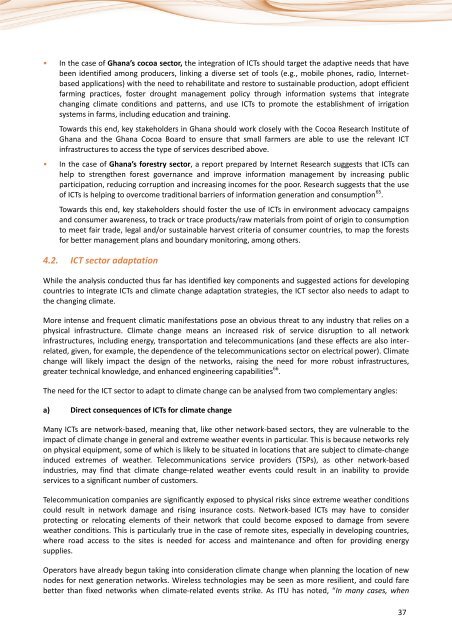Information and communication technologies (ICTs) and ... - ITU
Information and communication technologies (ICTs) and ... - ITU
Information and communication technologies (ICTs) and ... - ITU
You also want an ePaper? Increase the reach of your titles
YUMPU automatically turns print PDFs into web optimized ePapers that Google loves.
• In the case of Ghana’s cocoa sector, the integration of <strong>ICTs</strong> should target the adaptive needs that have<br />
been identified among producers, linking a diverse set of tools (e.g., mobile phones, radio, Internetbased<br />
applications) with the need to rehabilitate <strong>and</strong> restore to sustainable production, adopt efficient<br />
farming practices, foster drought management policy through information systems that integrate<br />
changing climate conditions <strong>and</strong> patterns, <strong>and</strong> use <strong>ICTs</strong> to promote the establishment of irrigation<br />
systems in farms, including education <strong>and</strong> training.<br />
Towards this end, key stakeholders in Ghana should work closely with the Cocoa Research Institute of<br />
Ghana <strong>and</strong> the Ghana Cocoa Board to ensure that small farmers are able to use the relevant ICT<br />
infrastructures to access the type of services described above.<br />
• In the case of Ghana’s forestry sector, a report prepared by Internet Research suggests that <strong>ICTs</strong> can<br />
help to strengthen forest governance <strong>and</strong> improve information management by increasing public<br />
participation, reducing corruption <strong>and</strong> increasing incomes for the poor. Research suggests that the use<br />
of <strong>ICTs</strong> is helping to overcome traditional barriers of information generation <strong>and</strong> consumption 65 .<br />
Towards this end, key stakeholders should foster the use of <strong>ICTs</strong> in environment advocacy campaigns<br />
<strong>and</strong> consumer awareness, to track or trace products/raw materials from point of origin to consumption<br />
to meet fair trade, legal <strong>and</strong>/or sustainable harvest criteria of consumer countries, to map the forests<br />
for better management plans <strong>and</strong> boundary monitoring, among others.<br />
4.2. ICT sector adaptation<br />
While the analysis conducted thus far has identified key components <strong>and</strong> suggested actions for developing<br />
countries to integrate <strong>ICTs</strong> <strong>and</strong> climate change adaptation strategies, the ICT sector also needs to adapt to<br />
the changing climate.<br />
More intense <strong>and</strong> frequent climatic manifestations pose an obvious threat to any industry that relies on a<br />
physical infrastructure. Climate change means an increased risk of service disruption to all network<br />
infrastructures, including energy, transportation <strong>and</strong> tele<strong>communication</strong>s (<strong>and</strong> these effects are also interrelated,<br />
given, for example, the dependence of the tele<strong>communication</strong>s sector on electrical power). Climate<br />
change will likely impact the design of the networks, raising the need for more robust infrastructures,<br />
greater technical knowledge, <strong>and</strong> enhanced engineering capabilities 66 .<br />
The need for the ICT sector to adapt to climate change can be analysed from two complementary angles:<br />
a) Direct consequences of <strong>ICTs</strong> for climate change<br />
Many <strong>ICTs</strong> are network-based, meaning that, like other network-based sectors, they are vulnerable to the<br />
impact of climate change in general <strong>and</strong> extreme weather events in particular. This is because networks rely<br />
on physical equipment, some of which is likely to be situated in locations that are subject to climate-change<br />
induced extremes of weather. Tele<strong>communication</strong>s service providers (TSPs), as other network-based<br />
industries, may find that climate change-related weather events could result in an inability to provide<br />
services to a significant number of customers.<br />
Tele<strong>communication</strong> companies are significantly exposed to physical risks since extreme weather conditions<br />
could result in network damage <strong>and</strong> rising insurance costs. Network-based <strong>ICTs</strong> may have to consider<br />
protecting or relocating elements of their network that could become exposed to damage from severe<br />
weather conditions. This is particularly true in the case of remote sites, especially in developing countries,<br />
where road access to the sites is needed for access <strong>and</strong> maintenance <strong>and</strong> often for providing energy<br />
supplies.<br />
Operators have already begun taking into consideration climate change when planning the location of new<br />
nodes for next generation networks. Wireless <strong>technologies</strong> may be seen as more resilient, <strong>and</strong> could fare<br />
better than fixed networks when climate-related events strike. As <strong>ITU</strong> has noted, “In many cases, when<br />
37

















